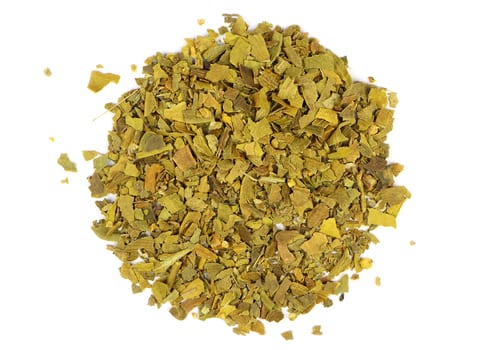Raw Cut Mistletoe
One of the most well-known evergreens, the mistletoe has inspired fascination throughout history, and is held in esteem for its medicinal and perceived magical properties.
Plant Constituents of Mistletoe
Action: If taken as a tea, Mistletoe should always be used as a cold infusion
antispasmodic [an agent which relieves or eases muscular spasms, cramps or convulsions]
cardio-tonic [an agent that stimulates or otherwise affects the heart]
diuretic [an agent that increases the volume and flow of urine which cleanses the urinary system]
emetic [an agent that causes vomiting]
hypotensive [lowers blood pressure]
narcotic [a drug which relieves pain and induces sleep when used in medicinal doses; large doses of narcotics produce convulsions, stupor, insensibility, coma or death]
nervine [an agent that has a calming or soothing effect on the nerves, any agent that acts on the nervous system to restore the nerves to their natural state]
stimulant [an agent that excites or quickens the functional activity of the tissues giving more energy]
tonic [an agent that tones, strengthens and invigorates organs or the entire organism giving a feeling of well-being]
tranquilizer
vasodilator [an agent that widens the blood vessels, lowering blood pressure]
Usage of Mistletoe
Medicinal Parts Used: Leaves, young twigs, berries
Mistletoe is used in small doses for:
Blood Conditions
bleeding from the lungs or intestines caused by typhoid or dysentery
disturbance in blood circulation, combined with Horsetail
internal and external hemorrhage
nosebleed
Brain and Nervous System Conditions
convulsions
convulsive nervous disorders
delerium
dizziness
epilepsy
headache
hysterical complaints
nerves
nervous debility
neuralgia
St. Vitus’s Dance
weakened state of the Nervous System
Cardiovascular Conditions
arteriosclerosis
hardening of the arteries
heart disease (lessens reflex irritability while raising the frequency of a slow pulse)
heart and circulatory complaints
heart flutters
normalizes circulation
poor circulation
prevention and treatment of strokes
raises low blood pressure, combined with Yarrow, Rosemary and Hawthorn
reduces high blood pressure, combined with Hawthorn, Horsetail and Garlic
strengthens the heart
It is used for the side effects of abnormal blood pressure, such as:
blood rushing to the head
buzzing in the ear
dizziness
visual defects
Female Conditions
bleeding after childbirth
chronic cramping
female infertility
heavy menstruation
uterine and menstrual disorders
It is also helpful for women during menopause for:
breathing difficulties
feelings of anxiety
heart palpitation
hormonal imbalance
hot flushes
normalizing circulation
Gastrointestinal Conditions
faulty digestive processes
Glandular Conditions
benefits the whole glandular system
favorably influences the pancreas
stimulates glandular activity relating to digestion
Gastrointestinal Conditions
debility of the digestive system, combined with Cayenne
Genitourinary System Conditions
urinary disorders
Inflammatory Conditions
arthritic pain
Metabolic Conditions
aids metabolism
chronic metabolic disorders
diabetes
Other
cancer
lack of energy and unwillingness to work
It is used externally for:
chill blains
frost bite
sores
ulcers
varicose veins
Other Uses:
The Thrush bird eats the berries
Winter fodder for sheep
Recommended dosage is as follows:
20-40mL per week of 1:2 fluid extract
Abstract PubMed: Cancer
The molecular and cellular mechanisms by which mistletoe (Viscum album L.) extracts exert cytotoxic and immunomodulatory anti-tumoral effects are largely unknown. In this study the hypothesis that Iscador preparations induce tumor regression by cell cycle inhibition and/or interference with apoptotic signaling pathways in cancer cells was investigated. Also a possible effect on angiogenesis, which is a prerequisite for tumor growth in vivo, is studied in endothelial cell cultures. Furthermore, it was examined which apoptotic signaling route(s) is (are) activated by Iscador by studying specific pro-apoptotic proteins in cultured cells. To characterize these properties, 9 human cancer cell lines of different origin, one epidermis derived cell line and 2 endothelial cell cultures were incubated with different concentrations of Iscador Quercus Spezial and Iscador Malus Spezial. Cell cycle kinetic parameters were measured by bromodeoxyuridine (BrdU) pulse labeling and tubulin staining. Apoptotic responses were detected by M30 Cyto-Death or Annexin V/propidium iodide assays. Characterization of the apoptotic pathway(s) was performed by staining cells for amongst others active caspase 3 and cytochrome C (mitochondrial pathway), as well as active caspase 8 (death receptor pathway). The sensitivity to Iscador treatment varies strongly between different cell lines and also ing those derived from small cell lung cancer, and adenocarcinoma of the lung and breast, as well as endothelial cell cultures, Iscador caused early cell cycle inhibition followed by apoptosis in a dose dependent manner. Amongst the low responders are cell lines derived from colorectal carcinoma. In general Iscador Malus exerted a stronger response than Iscador Quercus. Apoptosis was induced by activating the mitochondrial but not the death receptor dependent pathway, at least in case of Iscador Quercus. Iscador Malus also seemed to induce apoptosis via the death receptor route, which may explain the higher sensitivity of cancer and endothelial cells to this preparation.












Reviews
There are no reviews yet.